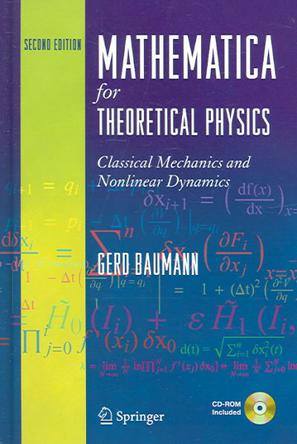-

Mathematica基础与应用
《Mathematica基础与应用》通过大量精选的实例,讲解Mathematica的符号运算、图形、高精度计算、程序设计等基本功能,介绍它在高等数学、线性代数、微分方程、概率统计、计算方法、运筹学与数学建模等课程中的应用。《Mathematica基础与应用(附光盘)》还通过作者丁大正的开发实例,详细介绍了用户如何编写、调用自己的程序包。书中还配有习题和习题解答,这些习题大多来自当今被广泛使用的数学教材,展示了软件的实用性。在《Mathematica基础与应用》附带的光盘中,还有作者开发的线性代数和常微分方程解题程序包及详细使用说明,其特点是能够逐步显示解题过程,而且力求与教科书上的题型与解法全面配套。光盘中还有一些基本操作的视频。 《Mathematica基础与应用》对初学者经常遇到的问题书中几乎都有解答,能快速引领读者熟练使用这个软件,特别适合自学者使用,既可以全面深入地学习,又可以即查即用。 -

Mathematica for Theoretical Physics (2nd edition)
Review From the reviews of the second edition: "The new edition contains a lot of additional material and new examples, and more emphasis is put on an interactive problem solving. In particular, advantage is taken of many special functions and frequently used operations which are available in Mathematica, in order to demonstrate how Mathematica can be used to replace lengthy ‘by-hand’ calculations and to give graphical support. The book is accompanied by a CD-ROM containing examples and programs." (M. Plum, Zentralblatt MATH, Vol. 1095 (21), 2006) Product Description Class-tested textbook that shows readers how to solve physical problems and deal with their underlying theoretical concepts while using Mathematica® to derive numeric and symbolic solutions. Delivers dozens of fully interactive examples for learning and implementation, constants and formulae can readily be altered and adapted for the user’s purposes. New edition offers enlarged two-volume format suitable to courses in mechanics and electrodynamics, while offering dozens of new examples and a more rewarding interactive learning environment. CD-ROM presents the entire text contents and interactive examples in Mathematica® Notebooks for problem solving and learning. From the Back Cover Mathematica for Theoretical Physics: Electrodynamics, Quantum Mechanics, General Relativity, and Fractals This second edition of Baumann's Mathematica® in Theoretical Physics shows readers how to solve physical problems and deal with their underlying theoretical concepts while using Mathematica® to derive numeric and symbolic solutions. Each example and calculation can be evaluated by the reader, and the reader can change the example calculations and adopt the given code to related or similar problems. The second edition has been completely revised and expanded into two volumes: The first volume covers classical mechanics and nonlinear dynamics. Both topics are the basis of a regular mechanics course. The second volume covers electrodynamics, quantum mechanics, relativity, and fractals and fractional calculus. New examples have been added and the representation has been reworked to provide a more interactive problem-solving presentation. This book can be used as a textbook or as a reference work, by students and researchers alike. A brief glossary of terms and functions is contained in the appendices. The CD-ROM accompanying each of the two volumes contains Mathematica® notebooks as well as Mathematica® programs. The notebooks contain the entire text of the corresponding volume and can interface with Mathematica®. The examples given in the text can also be interactively used and changed for the reader’s purposes. -

Mastering Mathematica
Book Description This new edition of Mastering Mathematica focuses on using Mathematica as a programming language, because programming in Mathematica is the best way to use the software to its fullest capacity. The book covers functional programming, imperative programming, rewrite programming, and object-oriented programming. It also addresses the use of Mathematica as a symbolic manipulator and a general tool for knowledge representation. * Focus on four different types of programming styles with Mathematica: functional programming, rewrite (or rule-based) programmng, imperative (or procedural) programming, and object-oriented programming, with many examples of each style * Compatible with Mathematica 3.0 and its programming language * Chapters on graphics programming show how to make the most of the considerable graphics capabilities of Mathematica * Includes coverage of programming needed for creation of Mathematica packages that allow a user to extend the language as needed for particular uses * Applications include: * Polya pattern analysis * Critical points of functions * Object-oriented graph theory * Minimal surfaces * Mathematica-Enhanced CD-ROM Enclosed * Complete text in active Mathematica Notebook files, enhanced for v3.0; Allows you to evaluate complex examples without retyping; Extensive use of the v3.0 math typesetting system * Hyperlink index and table of contents * Instant access to any chapter or topic * Index is automatically merged with the main Mathematica help system forming a master index of all the user's Mathematica related information; Quickly see listings on a given topic from The Mathematica Book, Mastering Mathematica, the Guide to Standard Packages, or any other Help Browswer aware books you have installed Book Info Addresses the use of Mathematica as a symbolic manipulator, a programming language, and a general tool for knowledge representation. Compatible with Mathematica 3.0 and its programming language. Paper. CD ROM included. DLC: Mathematica (Computer file) -

Mathematica
-

The Mathematica GuideBook
This comprehensive, detailed reference provides readers with both a working knowledge of Mathematica in general and a detailed knowledge of the key aspects needed to create the fastest, shortest, and most elegant implementations possible. It gives users a deeper understanding of Mathematica by instructive implementations, explanations, and examples from a range of disciplines at varying levels of complexity. The three volumes -- Programming, Graphics, and Mathematics, total 3,000 pages and contain more than 15,000 Mathematica inputs, over 1,500 graphics, 4,000+ references, and more than 500 exercises. This first volume begins with the structure of Mathematica expressions, the syntax of Mathematica, its programming, graphic, numeric and symbolic capabilities. It then covers the hierarchical construction of objects out of symbolic expressions, the definition of functions, the recognition of patterns and their efficient application, program flows and program structuring, and the manipulation of lists. An indispensible resource for students, researchers and professionals in mathematics, the sciences, and engineering. -

Computer Science With Mathematica
这本书用Mathematica的语言描述了计算机的工作方式。